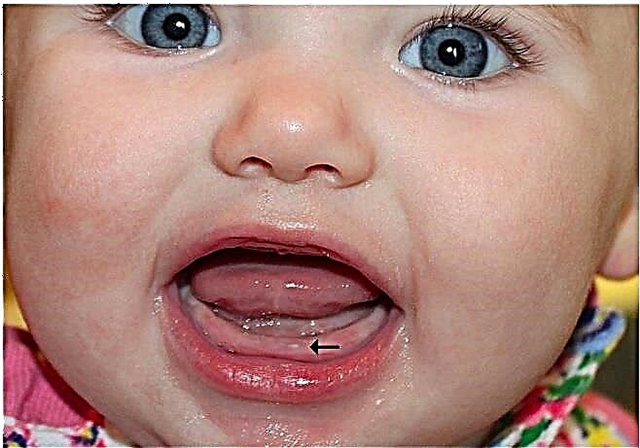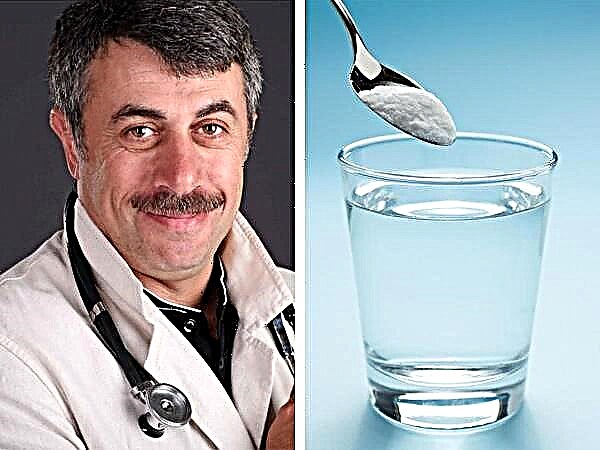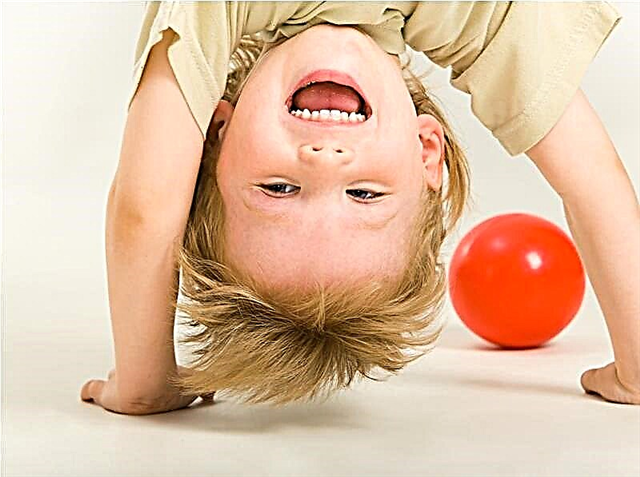Toothache is very difficult to endure. Adults and children suffer and suffer. It's good for babies - they have no teeth at birth, and they definitely will not get sick. Although the appearance of milk teeth in newborns is also associated with pain and discomfort. When do babies start cutting teeth? During this period, the parents have a difficult time, the baby will need their help.

The first milk teeth in a child
Timing of eruption
Baby's teeth are formed in the womb, long before birth. Already at 7-8 weeks of pregnancy, the rudiments of milk teeth are laid, and closer to 4-5 months, permanent teeth are formed. This early formation of hard tissue requires a sufficient amount of calcium, which should be consumed by the expectant mother. These can be foods rich in calcium or mineral complexes fortified with it. The accumulation of mineral salts in the tissues occurs throughout pregnancy and continues after the appearance of the crown above the gum.
Important! To eliminate the risk of infection, the pregnant woman herself must have healthy teeth.
What time do babies' teeth cut? The term of their appearance is significantly affected by heredity. Not only is she alone - there are a number of other factors that can slow down their growth. These include:
- frequent illnesses or diagnosed rickets;
- the nature of the diet;
- drinking water quality;
- climatic zone - the inhabitants of the northern regions have teeth a little later than the southerners;
- gender of the child - in boys, milk teeth appear a little later than in girls.
The average age of the appearance of the first tooth in a child, which is most often found in practice, is 6 months. This period is not a benchmark and should not become a reason for worry if it is not yet in six months.
Important! Deviation from the norms of statistics even for 6 months is not a pathology. There are times when a baby's teeth begin to cut at 2-3 months, and some children are born with teeth. It is also common for children whose first tooth has erupted after 1 year.

The timing of the appearance of teeth is individual
First symptoms
Cases such as "unexpected" appearance of a tooth are very rare. Most often, the baby experiences severe discomfort or even pain. By the following symptoms, you can find out when the first teeth begin to grow in infants:
- profuse salivation begins;
- redness and swelling of the gums;
- moodiness, spoiled mood and loss of appetite;
- itching of the gums, due to which the baby pulls everything into his mouth.

Symptom of the imminent appearance of teeth - the baby pulls everything into his mouth
Such signs are most characteristic of teething. The period when the tooth begins to come out of the gums can be accompanied by a painful condition similar to ARVI. It has the following symptoms:
- temperature;
- cough;
- runny nose;
- diarrhea.
There is no unequivocal opinion of doctors about the cause of the onset of these symptoms during the period when babies have their first teeth. For treatment, preventive measures are usually recommended, standard for the diagnosis of ARVI or ARI. Medical science does not trace a clear relationship between the appearance of a tooth and an increase in temperature. It can be said unambiguously that during the period of eruption, the child is in the "risk zone" and, due to the weakened organism, can really pick up an infection.
Normal teething order
There are 20 milk teeth in a child at the age of 2-3 years. Dentists have developed the formula. According to it, you can roughly calculate the number of teeth that a baby should have by a certain age:
N = n-4, where N is the number of teeth, n is the age in months.
The standard teething sequence is also derived. It shows which tooth should appear first, and which one - behind it.
Phased scheme of teething
| P / p No. | Name of teeth | Time of appearance, in months |
|---|---|---|
| 1 | central lower incisors | 6-7 |
| 2 | central upper incisors | 8-9 |
| 3 | lateral upper incisors | 10 |
| 4 | lateral lower incisors | 12 |
| 5 | upper first molars | 12-13 |
| 6 | lower first molars | 13-15 |
| 7 | upper canines | 15-18 |
| 8 | lower canines | 18-20 |
| 9 | lower second molars | 20-25 |
| 10 | upper second molars | 20-30 |
Important! Any other eruption sequences are not pathological.

The timing and name of milk teeth
Milk first teeth in babies have their own specific characteristics:
- small size;
- thin protective enamel and fabric;
- low level of mineralization;
- fragility;
- high risk of damage and infection.
Therefore, dental care should be started when the child's first tooth just appears. Silicone brushes are a good place to start. They simultaneously serve to massage and clean teeth, and also help to erupt and grow the next teeth. It is necessary to brush in a circular motion, moving from the distant teeth to the central incisors, twice a day. Better yet, after every meal.
Starting from a year, it is necessary to acquire a children's toothbrush and a special paste that is appropriate for age. The amount of paste on the brush is about a small pea. The baby will first swallow such a paste, then it is necessary to teach him to rinse his mouth after cleaning. Up to 3 years old, brushing your teeth must be supervised and supervised by adults. Also, dentists advise to "clean up" - to help the child get rid of plaque and food debris.

Dental care with a silicone brush
Most painful teeth
There are times when the first tooth of a child climbs very painfully. According to the state of the crumb, it is clear that the pain is really strong. Exceptions to this rule are rare. The sharp edges of the tooth literally tear apart the sensitive gum.
Interesting. Although parents often tell how they "quietly climbed out" all the teeth, except for the canines. Their turn takes about a year and a half.
The most severe pain is caused by the upper canines, which are also called "eye" teeth. They are very close to the facial nerves, so they cause the most severe troubles. It is during this period that the temperature may rise, which, miraculously, even without treatment, "disappears" after the appearance of the long-awaited white tooth above the gum.
Help from parents
Usually, after the appearance of the next tooth, the child, as well as the whole family, feel relief. Appetite was restored, mood improved, and sleep became calm and prolonged. The teething period itself can be very painful and hectic. The question immediately arises: how to help the baby through a difficult time and relieve suffering? To do this, you can use time-tested tools.
Conventionally, all methods for relieving negative symptoms can be divided into two groups: medicines and folk remedies.
Dosage forms
Syrups and suppositories based on ibuprofen and paracetamol
These are the most popular and approved medicines for infants. They really relieve pain and can also reduce fever. They should be taken according to the instructions, the required amount for one dose of the medicine is calculated by the weight of the child. Do not take more than 3-4 times a day, depending on the active ingredient, and daily for more than 3 days.

Approved medicines in the form of syrups based on ibuprofen and paracetamol
Gels and ointments with a cooling and analgesic effect
The trade names of the gels are “Holisal”, “Kalgel”, “Dentinox”, etc. A small amount of the gel is applied to the finger of a mother or another adult and rubbed into the gum. Before use, you should consult a pediatrician about the safety and timing of use of a particular drug. After the first use, track the reaction to the drug used so as not to use a product that will only harm the baby's health.

Cooling gels
Folk remedies
Ice or special teethers with liquid
A piece of ice should be wrapped in a thin sterile cloth, you can use gauze, rub the swollen gum several times with it. Pre-chill the teether toy in the freezer and give it to the baby for “pickling”.
Small pieces of frozen fruit
If the child is already given complementary foods, the baby knows how to chew, you can offer him popsicles: freeze a slice of a banana or apple and offer to nibble.
Massaging the gums by chewing solid food
For children under one year old, you can use a special device - a nibbler. It is a mesh bag in which you put hard pieces of fruit, crackers or cheese. In the process of eating, the pieces are "rubbed" by the gums and teeth in mashed potatoes.

Nieblers
The kid is going through difficult times, therefore, he needs increased attention and care. It makes sense to temporarily put aside the schedules and modes of the day. Instead, spend more time with the child, pick up more often, soothe and lull.
If the baby is breastfed, then applying to the breast more often is definitely the best sedative. In no case should you stop it during this period - now is not the right moment for another stress. It is also temporarily better to refrain from receiving guests and walking in crowded places - the real risk of catching an infection is very high. For this reason, in agreement with the pediatrician, you can transfer the planned preventive vaccination.
Important! It is strictly forbidden to press on the swollen gums, pick and cut the swelling area with toothpicks, tweezers and other devices, and also use solutions containing alcohol to treat the gums. Such manipulations will cause injury, more pain, and may cause an infection in the mouth.
Interesting. There is a custom to organize a holiday when the first tooth appears. As a congratulation, the hero of the occasion is presented with a silver spoon. This tradition goes back to the period when complementary foods began to be given with the appearance of the first tooth. Therefore, the spoon was very useful.
When a doctor is needed
The appearance of teeth does not always go well. First of all, you need to monitor the general condition of the baby, his behavior and appetite. If during the period when the next tooth began to come out, alarming symptoms such as diarrhea, vomiting and high fever appeared, this is a reason to immediately seek medical help and not self-medicate.
Increased salivation can cause irritation on the skin around the mouth and cheeks. An unpleasant sour odor may appear from the mouth due to partial decomposition of the mucous membrane on the gums and the appearance of a small amount of blood in the oral cavity.
Dangerous complications
In addition, various pathologies may appear, the cause of which must be consulted with a dentist. These manifestations include the following:
- Adentia is the absence of tooth buds. In the absence of teeth and even signs of their eruption at the age after one year, it is necessary to take an X-ray for the presence of primordia in the gums;
- The black edging on the milk tooth is a consequence of the use of iron preparations;
- The light brown color of a baby's tooth in a child indicates that a pregnant woman has taken antibiotics during the period of bearing a child or a baby during a neonatal period;
- Malocclusion due to uneven growth of the jaw occurs with prolonged sucking on the nipple;
- Incorrect placement of the teeth - this is influenced by constitutional causes, trauma or congenital disorder in the formation of connective tissue;
- Stomatitis in the oral cavity - the appearance of small ulcers on the mucous membrane;
- Gum hematoma - occurs when a blood vessel is disturbed.

Hematoma on the upper gum
All such manifestations require the advice of a pediatric dentist, who will explain how to properly care for and protect baby teeth.
There is no exact answer to the question of what time babies' teeth climb. We can definitely say that before one year there is no reason to panic if the tooth has not yet erupted. If this still does not happen, you should see a doctor for examination. If the teeth begin to grow, they need to be looked after and regularly shown to a specialist. Remove all painful symptoms with increased attention, care and, if necessary, proven means.



